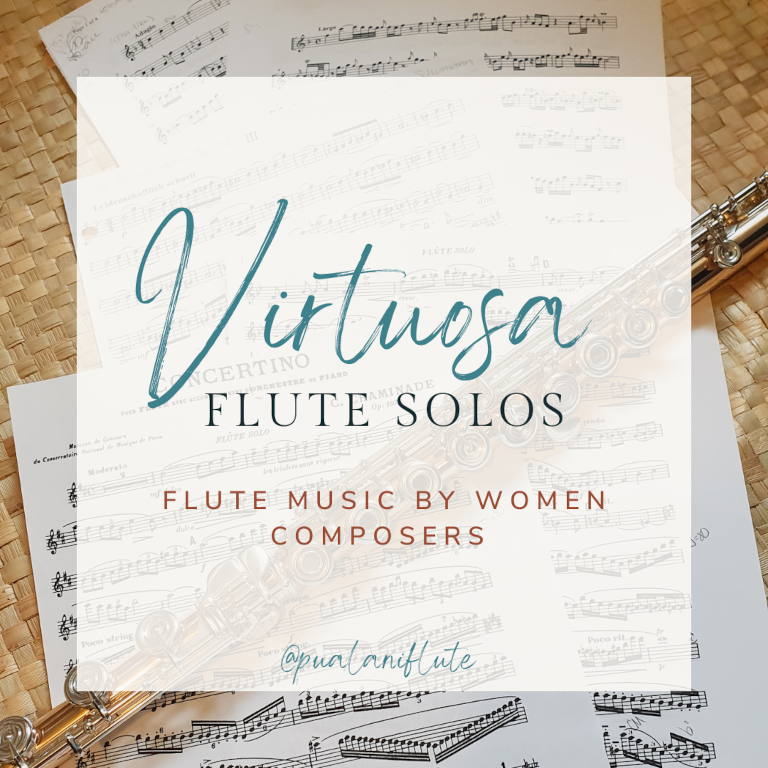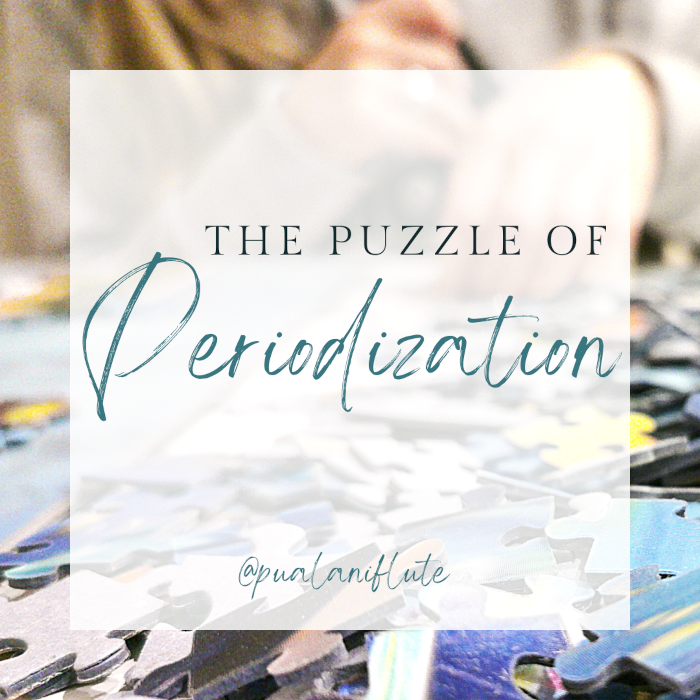Back by popular demand, here’s a follow-up to my blog post on free flute music by women composers! (In case you missed part one, click here to check it out!). In this round, I’m sharing another six hidden gems for flute and piano or harp that are accessible for free on IMSLP.
While part one covered music from the Baroque through Romantic eras, this post picks up in the late 19th century and continues into the 20th century, with a couple contemporary flute solos already in the public domain.

Even though 1870-1945 isn’t a traditional era in Western classical music, it was an important time period for women instrumentalists. These decades saw an increase in women who played orchestral instruments (not only strings, but also winds and brass!) and the formation of all-women orchestras across Europe and the United States. Many women’s activist organizations were also founded, like the Society of Women Musicians in London – and while they weren’t technically suffragist organizations, they were equally influenced by the ideals of first wave feminism.
Most of the pieces in this post fall into that time period – and while some were composed by women who had their roots in Romantic era compositional techniques, others began to branch out into more experimental tonalities and methods.
Although some of the pieces below were never printed during the composer’s lifetime, others have modern publications. However, these older editions are still valuable as they can help bring down the barrier of cost in programming music by women composers.
If you’re looking to try something new this Women’s History Month, check out my recommendations below! You can access the sheet music downloads by clicking the links in the titles. (And just in case this needs to be said, I’m not affiliated with or sponsored by IMSLP in any way – these are just compositions I’ve enjoyed and wanted to help spread the word about!)
1) Rita Strohl – Solitude (Rêverie) (1897)
Rita Strohl (1865-1941) was a French prodigy who enrolled in the Paris Conservatory at age 13. She attended Conservatory classes in piano and music theory, while taking private lessons in voice and composition. Strohl’s music was known for having religious and spiritual themes, and she primarily composed chamber music for piano and voice.
Solitude (Rêverie) is a ‘song without words’ inspired by Schubert’s lieder. Strohl initially composed the piece as a cello solo with piano accompaniment in 1887, but when Enoch & Cie. published it 10 years later, they included a violin transcription to help increase sales.
The violin version is playable on flute, and has become one of my new favorite pieces. This intermediate level solo has beautiful, lyrical melodies in the low register. However, it also has a wide range, and is great for practicing smooth transitions and even tone across all registers.
2) Clémence de Grandval – Valse Mélancolique (1898)
Throughout her career, Clémence de Grandval proved that you don’t need a conservatory education to become a successful musician. She was a student of Chopin and Saint-Saëns, and continued to study music and compose even after the birth of her daughters – going against the norms of 19th century France.
Clémence published her works under several different pen names (including Marie Grandval) and participated in Parisian musical society as a composer, singer, and pianist for the Société Nationale de Musique and the Société des Compositeurs.
This recommendation is for my friends who are lucky enough to have a harpist in their chamber ensemble! Valse Mélancolique is often overlooked in favor of Grandval’s Suite de Morceaux because it’s a character piece. However, this is a charming intermediate-level flute and harp duo with expansive, lyrical melodies and graceful, idiomatic writing for harp. Clémence dedicated the piece to Paul Taffanel and Adolphe Hasselmans, who premiered it, fittingly, at a concert hosted by the Société Nationale de Musique.
3) Lili Boulanger – Nocturne (1911)
Lili Boulanger grew up in an extremely musical family – her mother was a singer, her father taught at the Paris Conservatory, and her sister Nadia is remembered as one of the most influential teachers of the 20th century. Although Lili died young from complications due to tuberculosis, she made waves in the short time that she had. She’s most remembered for becoming the first woman to win the Prix de Rome in 1913, at age 19.
Lili dedicated this piece to her dear friend, Marie-Danielle Parenteau – who was also a friend of her sister, Nadia, and the daughter of the latter’s optometrist. Nocturne can be performed as a short stand-alone work or as a larger, two-movement recital piece with another of Lili’s character pieces, Cortège. Both intermediate-level pieces are available for flute or violin and piano; however, only Nocturne has a flute transcription in the public domain.
4) Laura Netzel – Colibri, Op. 72 (1912)
Laura Netzel (pen name: N. Lago) was a pianist, composer, and philanthropist who used her concert proceeds to fund charities – including a children’s hospital and women’s shelter in Stockholm. Although Netzel was Swedish, she studied in Paris and composed in the French style. She was also a correspondent for the French periodical Le Monde Musicale.
Colibri doesn’t always show up in a search for flute solos since it was written for violin or flute and is sometimes only tagged as a violin composition. But if you loved Netzel’s Suite, Op. 33, this is a great piece to try out next! And like the Suite, this composition was also dedicated to a 19th century virtuoso flutist – Monsieur E.F. Lematte, who played at the Opéra Comique in Paris.
The title translates to “Hummingbird” – and like it’s namesake, it’s short and cute, with quick, fluttery motifs and a few sections that will give you a good workout on double tonguing. The score and flute part are scans of handwritten manuscripts – so this piece won’t be for everyone. (Historical women had limited access to publishing, and unfortunately, a lack of easily legible editions has contributed to the continued marginalization of composers from many underrepresented demographics).
However, even though I have yet to find a typeset copy of Colibri from a modern publisher, this piece is too fun to rule out entirely. If you’re looking for something fresh to add to a spring recital program, give this piece a try!
5) Hedwige Chrétien – Vision (1920)
Although little is known about Hedwige Chrétien’s personal life, her musical achievements are well-documented. Chrétien studied composition with Ernest Guiraud at the Paris Conservatory and won first prize in harmony in 1881, accompaniment in 1882, and counterpoint and fugue in 1887. She became a professor of music theory at the Conservatory in 1890… and coincidentally, her husband was a flutist.
Chrétien was a prolific composer in the French tradition with about 250 works, including piano, vocal, orchestral, and chamber pieces, along with a couple ballets and operas. Her music was known for clear writing, pure and rich harmonies, and charming melodies. Vision is an intermediate level piece for flute and piano.
6) Vivian Fine – The Flicker (1973)
Vivian Fine (1913-2000) was an American piano prodigy and composer who attended the Chicago Musical College and was a protégé of Ruth Crawford. She was also a member of Aaron Copland’s Young Composer Group and helped found the American Composers Alliance in 1937.
Fine composed over 140 pieces throughout her 68-year career, including chamber music and large-scale orchestral and vocal works. Her musical style incorporated a wide range of influences, but was known for having a free mode of expression and a sense of fun and humor.
The copy of The Flicker in the public domain is another handwritten score, but the lines are, for the most part, neatly ruled and spaced. Like Colibri, this piece was inspired by the flutters and darts of bird flight – Fine depicts the flicker of a bird flying outside her window in Bennington, Vermont with undulating lines, quick rhythmic motifs, slurred leaps, and intermingling birdsong. The Flicker is an advanced level solo for unaccompanied flute or piano right hand.
If this piece seems like an outlier on this list, you’re not wrong – it’s in the public domain already because it was donated by Vivian Fine’s estate. That said, a note of caution: the copyright notice on IMSLP lists a license that restricts public and for-profit performances; however, there are recordings of this piece on YouTube and the composer’s website only redirects to IMSLP for copies of the scores. If in doubt whether you can program this piece for your concert, contact the email address for resource inquiries listed on the composer’s website.
Additional Resources
Free Flute Solos, Part 1!!
In case you missed it, here’s my first repertoire guide rounding up my top picks for Baroque, Classical, and Romantic era flute solos available for free on IMSLP!
Virtuosa Flute Solos
Keep exploring the music of women composers from the past and present – check out my free resource on flute solos by women composers!
The Puzzle of Periodization
The late Romantic era/early 20th century was an important time for women in classical music. It was a transitional time when some composers were still very rooted in Romantic era techniques, while others were experimenting with innovations of harmony and form. Learn more about this era (and others that were important for historical women composers) by clicking the link above!


